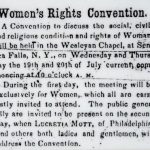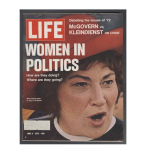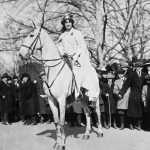Women’s Equality Day is the anniversary of women getting the right to vote. Here’s how to celebrate.
 BY SORAYA FERDMAN From Mashable
BY SORAYA FERDMAN From Mashable
Women’s Equality Day, celebrated annually on August 26, marks the date the Constitution was amended to include women’s right to vote.
“The right of citizens of the United States to vote shall not be denied or abridged by the United States or by any state on account of sex,” the 19th amendment read, as of August 26, 1920.
That sentence, my loves, took almost a century of organizing to achieve.
“Women’s Equality Day reminds all Americans of their power as citizens to create their own unrelenting, brilliant, courageous, political campaign to ensure equal opportunity for all,” says Molly Murphy MacGregor, the executive director and co-founder of Women’s National History Museum.
An abbreviated history of women’s suffrage
Women in the United States were politically active long before they got voting rights. In the 1820s and 1830s, they congregated to discuss issues such as abolition, temperance, and religion. However, the effort to build a national coalition of women dedicated to guaranteeing women’s suffrage did not pick up until after the Civil War.
The Seneca Falls Convention in 1848 gave women’s suffrage a much-needed spotlight. Though it did not bring about any direct political change, the event did solidify suffragists’ goals and purpose.
An excerpt from a local newspaper, Seneca County Courier, that advertised the 1848 convention.
An excerpt from a local newspaper, Seneca County Courier, that advertised the 1848 convention.
IMAGE: VIA LIBRARY OF CONGRESS
In the decades that followed, women’s suffrage overlapped with abolition and the Civil War. When the 15th Amendment to the Constitution passed in 1870 and extended the right to vote to black males but said nothing about female citizens, many white women reacted to this exclusion with racist resentment.
In the 1880s, leading black women reformers like Ida B. Wells pointed out that white suffragists could not champion female equality while also turning a blind eye to lynching and racial segregation. Her observations reflected the split in the suffragist movement between those who believed in racial equality and those who did not.
By the turn of the century, women’s suffrage groups came together to plan various demonstrations and marches in the nation’s capital.
In March of 1913, a parade of 5,000 suffragists marched across the nation’s capital. This parade was strategically planned to coincide with Woodrow Wilson’s inauguration, exploiting the crowd to bring attention to women’s suffrage. Wearing a crown, sporting a white cape, and riding a horse, lawyer Inez Miholland Bolssevain led the march.
By 1918, more than a dozen states had extended voting rights to women. Between 1918 and 1920, the amendment guaranteeing women the right to vote successfully moved from the House of Representatives to the Senate. Once Congress passed the amendment, it was sent to the states for ratification.
The monumental achievement, however, fell far short of equality for black women (and men) who continued to face barriers to suffrage. Indeed, they were frequently met with violence and intimidation when they tried to vote. It was not until the Voting Rights Act of 1965 that racial discrimination in voting was prohibited by federal law. Yet, black Americans still face significant obstacles when they try to cast a vote.
Battling Bella: The woman behind Women’s Equality Day
Bella Savitzky Abzug (July 24, 1920 – March 31, 1998) was a feminist and civil rights advocate who refused to remain on the political sidelines. We have her to thank for Women’s Equality Day. She introduced the bill that would formally establish it as a day of recognition.
MacGregor sees Abzug’s legislation as strategic: “She put it on the federal calendar.”
In addition to general celebration, past presidents like Nixon and Obama have used the day to talk about the continued fight for equality.
Yet there is far more to this congresswoman than the founding of Women’s Equality Day.
“A women’s place is in the house – the House of Representatives.”
Abzug ran for elected office with the campaign slogan “A women’s place is in the house — the House of Representatives.” Once in Congress, she was known for proposing unapologetically progressive legislation, including one of the first LGBT civil rights bills in U.S. history.
Men inside Congress clashed with her. Men outside of Congress clashed with her. Abzug could care less.
“There are those who say I’m impatient, impetuous, uppity, rude, profane, brash and overbearing. Whether I’m any of these things or all of them, you can decide for yourself. But whatever I am—and this ought to be made clear from the outset—I am a very serious woman,” Abzug said in response to her critics.
Here’s how to celebrate Women’s Equality Day
While not a federal holiday, Women’s Equality Day can be used as an opportunity to educate yourself about women’s history and learn about new efforts to expand voting rights. Here are some actionable ways to keep the spirit of the suffrage movement alive:
Educate yourself about voting rights. Many Americans’ votes are actually suppressed. That’s because numerous states have passed laws that make it hard for marginalized communities, particularly communities of color, to vote. Whether it be new obstacles to registration, changes in early voting, or stricter voter ID instructions, these laws threaten our democracy.
Learn about women’s history. There are new efforts to highlight stories about women left out of traditional history books. For example, the New York Times recently started a new column in their obituaries section called “Overlooked.” The section profiles remarkable women the newspaper didn’t previously cover. The Rebel Girls children’s book series tells stories about extraordinary women. Finally, you can also turn to the nonprofit National Women’s History Museum in Washington D.C., which has ample public information on their website.
Support women running for office. A record number of women are running for government positions in the midterm elections. If they win at the ballot box, many of these candidates will be shattering their own glass ceilings. Stacey Abrams, for example, is facing an uphill battle to become the first black woman U.S. governor. Christine Hallquist, the first transgender person to win a primary governor election anywhere, might also make history. If you really want to celebrate National Women’s Equality Day, consider voting or otherwise supporting a female candidate whose values you share.
IMAGES:
Two members from the League of Women Voters dress as suffragists to celebrate Women’s Equality Day, on August 26, 2010.IMAGE: CHIP SOMODEVILLA VIA GETTY IMAGES
Bella Abzug on the cover of a 1972 issue of LIFE magazine.
IMAGE: PUBLISHED BY TIME VIA HISTORY.HOUSE.GOV
Lawyer Inez Miholland Boissevain leads the charge, looking like a straight-up goddess.
IMAGE: VIA LIBRARY OF CONGRESS
For more on this story go to: https://mashable.com/2018/08/26/what-is-womens-equality-day/?utm_source=feedburner&utm_medium=feed&utm_campaign=Feed%3A+Mashable+%28Mashable%29#Y.FSJfNUgqqH








